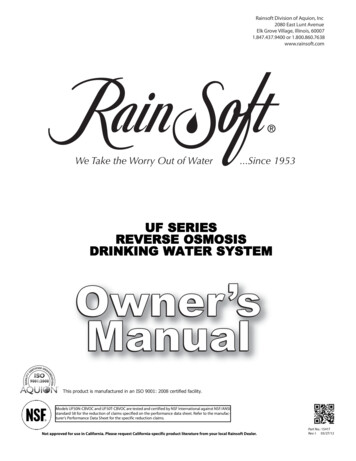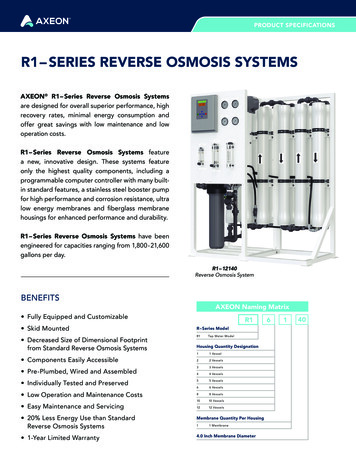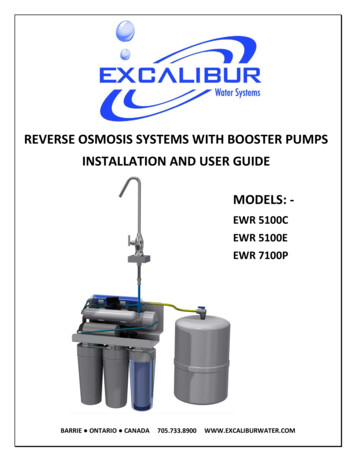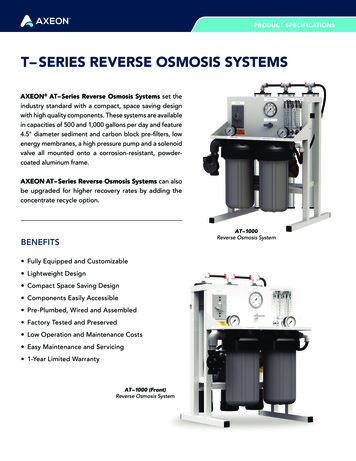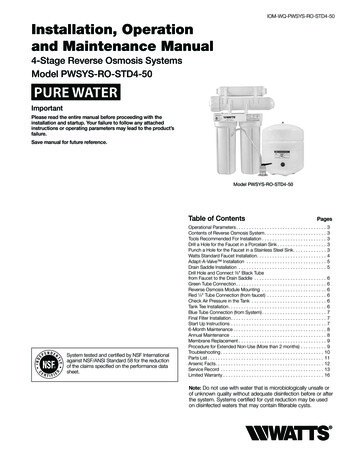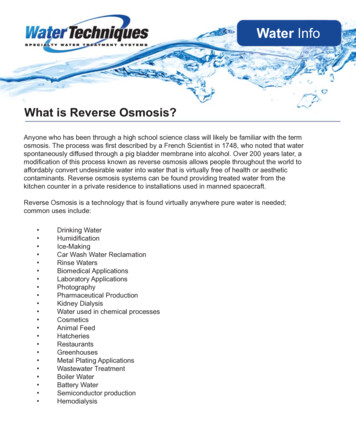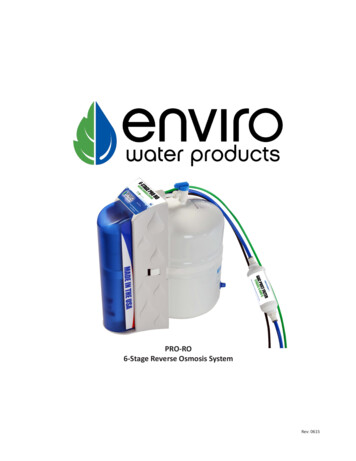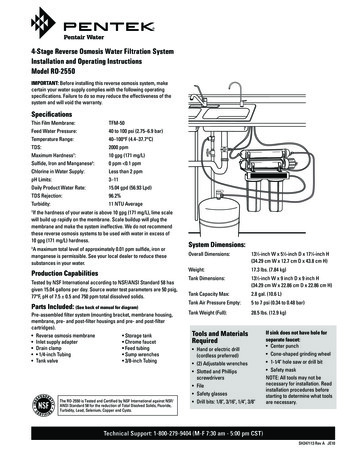
Transcription
International Journal of Latest Engineering Research and Applications (IJLERA) ISSN: 2455-7137Volume – 02, Issue – 05, May – 2017, PP – 54-59Reverse Osmosis Water Purification by Cycling Action12V K Ravi , Sushmitha V , M Venkata Praveen Kumar3, Amal Thomas41234(Department of Mechanical Engineering, Bangalore Technological Institute, India)Abstract: Pure water is very much essential to survive, but now a days the water is getting contaminated dueto Industrialisation which leads to many water-releated diseases. Reverse Osmosis(RO) Water Purification byCycling Action meets the needs of people without requiring any electrical energy. RO is a physical process thatuses the osmosis phenomenon, that is, the osmotic pressure difference between the salt water and the purewater to remove the salts from water. Water will pass through the membrane, when the applied pressure ishigher than the osmotic pressure, while salt is retained. As a result, a low salt concentration permeate stream isobtained and a concentrated brine remains at the feed side. A typical RO system consists of four major subsystem : pre-treatment system, high-pressure pump, membrane module and post treatment system. In operationby pedaling the cycle, man power is converted into mechanical energy which is further converted into hydraulicenergy in RO pump.Keywords: Cycling Action, Membrane, Osmotic Pressure, Reverse Osmosis1. IntroductionPure water is very much essential to survive but nowadays the water is getting contaminated due toindustrialization which leads to many water related diseases.In many developing countries, people walk manymiles to reach a source of water that is not necessarily potable.Water can contain dirt, minerals, chemicals andother impurities that make it smell and taste bad. Some of these contaminants can endanger health, especiallywhen they include microscopic organisms and bacteria that can cause serious illness. Filtering water can helppurify water, removing these impurities and making it safe to drink, while often improving its taste.A studyconducted by various sources compared different modern methods of water purification- distillation, ultra-violetlight, reverse osmosis, solid block activated carbon, granular activated carbon, water softeners, sediment filters,boiling, bottled water, ozonation, chlorination, ion exchange etc. Among all the above methods mentionedReverse Osmosis is best suited for issues which were originally designed for mainly two things, they are:desalination of brackish water or sea water and reducing very specific chemical contaminants. Reverse Osmosisis needed to remove Fluoride, sodium, total dissolved salts, or chemicals like arsenic, radium and nitrates. Inresponse to such a need, Reverse Osmosis Water Purification by Cycling Action is proposed to produce cleandrinking water which uses human power to get pure form of water for drinking.The term water purificationrefers to a process, which selectively extracts pure water from an impure solution, leaving all kinds of impuritiesbehind, regardless of their source or their nature. This is quite different than water treatment described above.There are only three scientifically recognized methods of water purification. These are: Distillation, freezethawing, and reverse osmosis (RO). Of these, reverse osmosis offers the most practical and economicalapproach to water purification. The equipment is compact, easy to operate, and it is highly energy-efficient, incomparison with distillation and freeze-thawing equipment. RO is an effective method of reducing theconcentration of total dissolved solids and many impurities found in water.2. LiteratureSurveyDustin [1], proposed a paper,which discovered whether human powered reverse osmosis is a viableoption for producing potable water for developing countries. A device was designed to test the practicality ofthis idea through a numerical analysis. The device uses a bicycle to harness human motion to convert it intousable power to run a reverse osmosis filtration system. The flow rate was determined according to giveninformation from the reverse osmosis manufacturer. It indicated that a human could easily provide enoughpower to run a reverse osmosis system such as this. The flow rate was then used to determine how useful thispower was by considering how fast it could produce clean drinking water and how much water a person needs todrink daily. Ultimately from all of the research and results, it was determined that human powered reverseosmosis is not only a viable option, but an incredibly economical and effective means for providing potablewater for developing countries.www.ijlera.com2017 IJLERA – All Right Reserved54 Page
International Journal of Latest Engineering Research and Applications (IJLERA) ISSN: 2455-7137Volume – 02, Issue – 05, May – 2017, PP – 54-59Anusha and Yash [2], have discussed this paper which analyzes the design of a pedal operated waterfiltration system to be used by local dwellers. It works on the principle of compression and suddenrelease of atube by creating negative pressure in the tube and this vacuum created draws water from the sump into the pumpwhile rollers push the water through to the filter where adsorption takes place to purify the water. The designcomprises of a peristaltic pump powered by pedaling, a filter and hose or flexible tube. As the operator sits onthe seat and pedals, the pedal crank transfers the motion to the rotor thus the rollers and the tube is squeezed bythe set of rollers to move the fluid. This design will reduce the labor, cost and weariness caused by transportingand sanitizing drinkable water for use.Anand and Ramprasad [3],had presented a seminar report, which involved reviewing the literatureregarding a variety of portable water purification techniques like boiling, solar water disinfection, sedimentationand ceramic filters coagulation, adsorption (activated carbon), chlorination, UV irradiation, ultra filtration,reverse osmosis and other combined methods that have been predominantly used at the household level. Theinformation on performance of these purifiers with respect to parameters like cost, availability, ease of use,dependence on utilities, and microbial efficacy was also mostly obtainable in the literature. The outlook of thisreport was to study, describe and contrast different portable water purifiers. The drinking water quality standardswere described and the issues related to the water quality in India were discussed. Subsequently, a suitableclassification mechanism and a comprehensive description of a wide spectrum of purifiers were covered. Areview based on multiple attributes was carried out to ascertain the appropriate choice for specific situations.Jayant et al. [4],have presented their paper about fabrication of PPWP. And experimentally investigatesthe working of Pedal Powered Water Pump (PPWP) along with its purification which has been used for puredrinking water supply and garden irrigation. PPWP will consist of a centrifugal pump operated by pedal power.The centrifugal pump is positioned on its stand in such a way that driven shaft of the centrifugal pump wasbutted to the bicycle wheel. By pedaling the bicycle, the bicycle wheel rotates, thereby rotating the centrifugalpump which in turns discharges water from the sump. PPWP provides drinking water and irrigation in remoteareas where electricity is not available. PPWP is not only free from pollution but also provide healthy exercise.PPWP reduces the rising energy costs. PPWP will design as a portable one which can be used for irrigation invarious places. The experimental investigation was executed and performance of the PPWP had carried out atdifferent rpm. The PPWP requires only manual power thereby reducing the utility bill considerably.Garud and Kulkarni [5], discussed and presented a paper in which Reverse Osmosis (RO) is amembrane based process technology to purify water by separating the dissolved solids from feed streamresulting in permeate and reject stream for a wide range of applications in domestic as well as industrialapplications. It is seen from literature review that RO technology is used to remove dissolved solids, color,organic contaminants, and nitrate from feed stream. Hence RO technology used in the treatment of water andhazardous waste, separation processes in the food, beverage and paper industry, as well as recovery of organicand inorganic materials from chemical processes as an alternative method . This paper intends to provide anoverall vision of RO technology as an alternative method for treating waste water in different Industrialapplications. The present short review shows applicability of RO system for treating effluents from beverageindustry, distillery spent wash, ground water treatment, recovery of phenol compounds, and reclamation ofwastewater and sea water reverse osmosis (SWRO) treatment indicating efficiency and applicability of ROtechnology.3. Working PrincipleThe entire process of the design begins by adding salt water into the tank. All the heavy sediment isimmediately removed as the water passes through several layered mesh micro filters. The initial filtering step iscrucial because the RO filter would quickly clog if it had to filter heavier sediments.To set the purificationsystem in motion we need to begin peddling the pedal. Since the pump mechanism is geared to minimize theeffort needed to operate it, the user feels little to no difference in having to power the pump system compared topedal a bicycle.The water then enters the four stages of the filters in RO system. Fig.1 Working Model.Fig. 1 working modelwww.ijlera.com2017 IJLERA – All Right Reserved55 Page
International Journal of Latest Engineering Research and Applications (IJLERA) ISSN: 2455-7137Volume – 02, Issue – 05, May – 2017, PP – 54-59The first stageremoves any very heavy sediment down to fine microns still left in the water that the firstset of filters did not catch.The second stage removes any unwanted color, taste and odor. These two stages prepare the water for the mostcrucial step Reverse Osmosis. Without these previous two filters, the RO membrane could easily be destroyedby certain chemicals that may be in the dirty water. The more filtered the water in before passing through theRO membrane, the longer the membrane will last.The third stageis the heart of the system as it removes all particles down to 0.0001 micron in size.The fourth and final stage is a repeat of the second stage, purely to optimize water quality. From here, the waterexits the system as potable water and rinse water. The purest water is used for drinking and the rinse water canbe used in many ways other than drinking such as irrigation, cleaning etc. so that water can never get wasted.3.1 Main ComponentsThe main components used to fabricate the model are: Filters Chain Drive with Sprocket Rotary Gear Pump3.1.1 FiltersA filter removes impurities from water by means of a fine physical barrier, a chemical process or abiological process. Filters cleanse water to different extents for purposes such as providing agriculturalirrigation, accessible drinking water, public and private aquaria, and the safe use of ponds and swimming pools.Filters use sieving, adsorption, ion exchanges, biological metabolite transfer, and other processes to removeunwanted substances from a quantity of water. And unlike a sieve or screen, a filter can potentially removeparticles much smaller than the holes through which its water passes.To effectively reduce the hardness/TDS from water supplied in locality, the technology that would suitbest is RO. Reverse Osmosis is the reversal of the natural flow of Osmosis. In water Purification system,Reverse Osmosis is used to separate the salts and other heavy metals from water. The RO technology usesReverse Osmosis for water purification, where in the water is passed at a high pressure through a thin filmcomposite membrane which reduces the dissolved salts and removes chemical and biological impurities and alsoreduces the high levels of TDS to the permissible drinking water limits. It makes water free from physical,chemical and disease-causing microbial contaminants, while it also improves the taste of water making it sweet.Fig.2 shows 4 stage filters.RO, 4 Stage Sediment Pre-Carbon RO Membrane Post-CarbonFig. 2 4 stage filters3.1.2 Chain Drive with SprocketChain drive is a way of transmitting mechanical power from one place to another. It is oftenused toconvey power to the wheels of a vehicle, particularly bicycles and motorcycles. It is also used in a wide varietyof machines besides vehicles. Most often, the power is conveyed by a roller chain, known as the drivechain or transmission chain, passing over a sprocket gear, with the teeth of the gear meshing with the holes inwww.ijlera.com2017 IJLERA – All Right Reserved56 Page
International Journal of Latest Engineering Research and Applications (IJLERA) ISSN: 2455-7137Volume – 02, Issue – 05, May – 2017, PP – 54-59the links of the chain. The gear is turned, and this pulls the chain putting mechanical force into the system asshown in Fig. 3 Chain Drive with Sprocket.A sprocket is a profiled wheel with teeth that meshes with a chain, track or other perforated or indentedmaterial. It is distinguished from a gear in that sprockets are never meshed together directly, and differs from apulley in that sprockets have teeth and pulleys are smooth.Sprockets are used in bicycles, motorcycles, cars,tracked vehicles, and other machinery to transmit rotary motion between two shafts where gears are unsuitableor to impart linear motion to a track, tape. Fig. 3 shows Chain drive with Sprocket.Fig. 3chain drive with sprocket3.1.3 Rotary Gear pumpA gear pump uses the meshing of gears to pump fluid by displacement. They are one of the mostcommon types of pumps for hydraulic fluid power applications.External gear pumps are similar in pumping action to internal gear pumps in that two gears come intoand out of mesh to produce flow. However, the external gear pump uses two identical gears rotating againsteach other one gear is driven by a motor and it in turn drives the other gear. Each gear is supported by a shaftwith bearings on both sides of the gear as shown in Fig.4.Fig. 4 working of pumpSpecification of pump used:TypeRotary Gear PumpModelEG-050Capacity20lpmInlet and Outlet size0.5x0.5 inchMotor Required0.5HPWeight2.3 kg4. ResultsThe trials are carried out using Reverse Osmosis Water Purification by Cycling Action for threedifferent samples of water. The below table shows the trials for different water samples:www.ijlera.com2017 IJLERA – All Right Reserved57 Page
International Journal of Latest Engineering Research and Applications (IJLERA) ISSN: 2455-7137Volume – 02, Issue – 05, May – 2017, PP – 54-59Trial 1:Sample water: Tank waterCapacity: 1440 ml/hrWater TypeWatertobefiltered from tankWater coming outof RO membraneWater which isfilteredthroughPost Carbon filterTable 1: Trial 1TDS value (ppm)Quantity (liter)998-8741.441194.56Table 2: Trial 2TDS value (ppm)Quantity (liter)875-7162.221144.8Table 3: Trial 3TDS value (ppm)Quantity (liter)743-5162.22485.4Trial 2:Sample water: Bore well waterCapacity: 2220 ml/hrWater TypeWatertobefiltered from tankWater coming outof RO membraneWater which isfilteredthroughPost Carbon filterTrial 3:Sample water: Bore well waterCapacity: 2220 ml/hrWater TypeWatertobefiltered from tankWater coming outof RO membraneWater which isfilteredthroughPost Carbon filter5. Advantages And DisadvantagesThe advantages, disadvantages, applications and future scope of this project are:5.1 AdvantagesThe advantages are as follows: Its operation and maintenance is very simple It is compact and portable. It is simple in process. Power saved and good exercise for human beings.5.2 DisadvantagesThe disadvantages are as follows: Slow production rate. Requires lots of water to produce pure water.www.ijlera.com2017 IJLERA – All Right Reserved58 Page
International Journal of Latest Engineering Research and Applications (IJLERA) ISSN: 2455-7137Volume – 02, Issue – 05, May – 2017, PP – 54-596. ConclusionThe pedal operated water filtration system is a new system that is useful in developing countries likeIndia to have daily access to safe drinking water all by harnessing the energy of pedal power.Reverse osmosis isa relatively new, but very effective application of an established scientific process. Whether it is used to meetthe needs of a typical family of four, or the needs of an industrial operation requiring thousands of gallons perday, it can be a cost effective to provide the required quantity of highly treated water. With continual advancesin system and membrane design that boost efficiency and reliability, RO can be expected to play a major role inwater treatment for years to come.In Reverse Osmosis Water purification by Cycling Action Simple in design. Portable. Economical. Effective way for providing potable water. Less maintenance.6.1 Future ScopeThe future scope includes redesigning the structure of the model and the type of pump to get higherpressure. The RO filters can be made combinations with UV filters to get high quality of pure water. Byincreasing the speed of cycling action higher rate of water flow can be created. The model can be redesigned into movable model from stationary model by using bicycle in which pump and filters can be attached usingsuitable mechanism, and it can be even used as a travelling device from one place to another place and hencepure water can be collected in separate container by the time the person reaches his destination.References[1] Drake, Human Powered Reverse Osmosis for Producing Potable Water for Developing Countries,Ninth LACCEI Latin American and Caribbean Conference(LACCEI’2011), Engineering for a SmartPlanet, Innovation, Information Technology and Computational Tools for Sustainable Development,Medellin, Colombia, 1(9), August 3-5, 2011, 1-6.[2] Anusha Pikle and Yash Siriah, Pedal Operated Water Filtration System (Mobifilt), InternationalJournal of Current Engineering and Technology , Department of Mechanical Engineering, ShriSavitribai Phule Pune University, Pune, India, 2(4),March 2016,254-258.[3] Anand B. Rao and Ramprasad V, Seminar Report on Portable Water Purifiers, Centre for TechnologyAlternatives for Rural Areas (CTARA), Indian Institute of Technology Bombay, Powai, Mumbai,November, 2014, 36-37.[4] Jayant Gidwani, Amit Kesheorey and Nitesh Lowanshi, “Pedal Powered Water Pumping andPurification”,ijsart.Department of Mechanical Engineering, Swami Vivekananda College OfEngineering Indore, Madhya Pradesh, 1(2), 5 May2016, 10-13.[5] Garud R. M. and Kulkarni G. S ‘’A Short Review on Process and Applications of Reverse Osmosis’’Universal Journal of Environmental Research and Technology Shivaji University, Kolhapur,Maharashtra, 1(1), 2011, 233-238.www.ijlera.com2017 IJLERA – All Right Reserved59 Page
best is RO. Reverse Osmosis is the reversal of the natural flow of Osmosis. In water Purification system, Reverse Osmosis is used to separate the salts and other heavy metals from water. The RO technology uses Reverse Osmosis for water purification, where in the water is passed at a high pressure through a thin film
